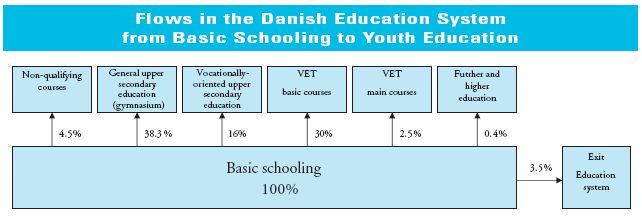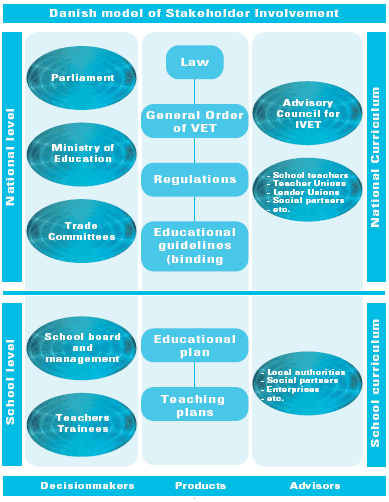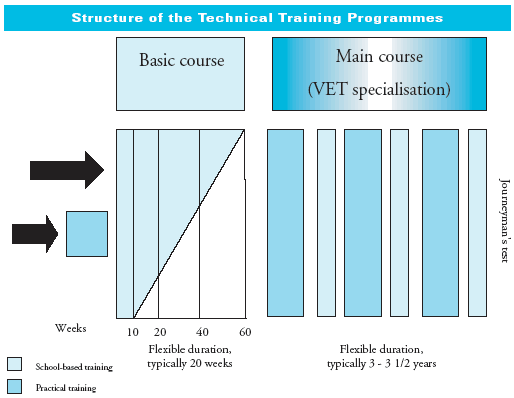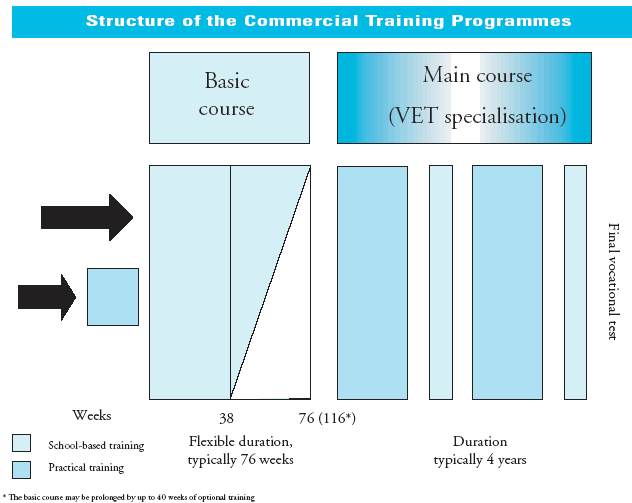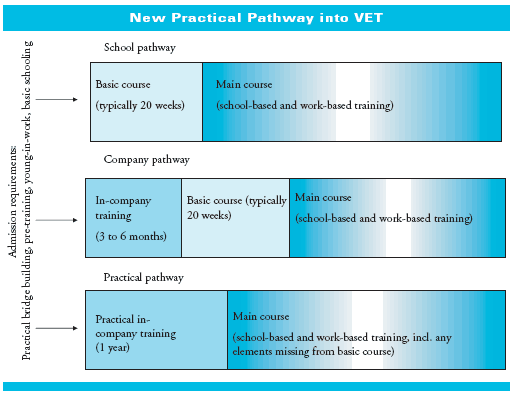
|

1 The Danish VET systemThe Danish VET system is part of the overall youth education system, and aims at developing both the general, personal and vocational skills of young people. The overall objectives of VET are laid down in the Act on Vocational Education and Training3. According to these, the aim of the programmes is not only to provide the trainees with vocational qualifications, which are formally recognised and in demand by the labour market, but also to provide them with general and personal qualifications that open up the trainees' possibilities for lifelong learning and for active citizenship. The system is based on three main principles:
A definition: Facts and figures about VET in Denmark: Approximately 30% of a youth cohort start a VET programme after basic schooling (2002). Of these, 27.1% complete a VET programme, with 9.2% completing a commercial training programme, 18.4% a technical training programme and 5% a social and health care training programme. Compared to the general upper secondary education programmes and the vocationally oriented upper secondary programmes, the number of young people entering a VET programme has dropped since 2000 – by 15% within the main courses of the commercial training programmes. The trend is currently for young people to opt for the more academically-oriented upper secondary education programmes. The number of male trainees in VET is, on average, marginally higher than the number of females trainees: with 55.6% male trainees on the basic courses and 54.7% male trainees on the main courses. However, the gender distribution between the various programmes is uneven. In social and health care subjects, the female trainees constitute 92.3%, whilst within traditionally male sectors such as mechanical engineering, transport and logistics they only constitute 4.3%. The average age of trainees on the basic courses was 20 in 2002. For the main courses, the average age was 25. In 2002, approximately 92% of all trainees were of Danish origin, and 8% were immigrants or from ethnic minorities. The completion rates vary from commercial to technical training programmes. In 2002, 79.1% completed the basic course within commercial training, whereas only 55.9% completed the basic course in technical training. In general, drop-out is a major problem in the Danish VET programmes, and reducing the number of drop-outs, especially in technical training, is an important political priority (please see 2.3.1, Practically- oriented young people). Approximately 80% of those completing a VET programme enter the labour market and are employed in a company one year after completion. Source: Uddannelse på kryds og tværs, The Danish Ministry of Education, 2004. Figure 1
Source: Uddannelse på kryds og tværs, The Danish Ministry of Education, 2004. 1.1. – an involving systemThe Danish VET system is characterised by a high degree of stakeholder involvement. Not only the social partners, but also colleges, enterprises, teachers and trainees are involved in a continuous dialogue about, and development of, the Danish VET system. The cooperation between the Ministry of Education and the social partners is very well developed, and the vocational colleges and the enterprises also share responsibility for the training of each individual trainee – all of which ensures that the qualifications obtained are well-known, and generally recognised in the labour market. The involvement of stakeholders creates a system which is based on consensus, and in which responsibilities are shared within clearly defined boundaries.
1.1.1. The Ministry of EducationThe Minister of Education is responsible for the general education policies, and for ensuring that the VET programmes are consistent with these policies. In regard to VET, the Ministry lays down the overall objectives for the VET programmes, and provides the framework within which the stakeholders, i.e. the social partners, the vocational colleges and the enterprises, are able to adapt the curricula and methodologies to the needs of the labour market and of the trainees. The Ministry is responsible for ensuring that the VET programmes have the breadth required for a youth education programme, and for the allocation of resources. The Ministry is furthermore responsible for approving new VET qualifications on the basis of recommendations from the Advisory Council for Initial Vocational Education and Training (Rådet for de grundlæggende erhvervsrettede uddannelser – REU), and for approving the colleges that are to provide the basic and main courses in VET. It is also the Ministry which lays down the overall rules for VET – in cooperation with the REU, and draws up the regulations on the individual VET programmes – in cooperation with the trade committees (please see 1.1.2 The social partners). The regulations are supplemented with guidelines drawn up by the trade committees and issued by the Ministry (please see Facts about legislative framework, p. 22). Finally, the Ministry is responsible for inspection and quality assurance; issues which are gaining in importance. The introduction of new steering principles such as framework governance and decentralisation in 1991 (please see 1.4.1 Reform 1989), which granted providers greater autonomy with regards to adapting VET provision to local needs and demands, accentuated the need to implement national quality approaches which, on the one hand, supported decentralisation, and on the other hand, ensured central control with the quality of VET provision. 1.1.2 The social partnersOne of the main characteristics of the system is the active participation of the social partners at all levels of the system. This guarantees that the content of the individual VET programmes meets the demands of the labour market, and that the qualifications are recognised by business and industry. The social partners are represented in a number of councils and committees acting at local, sectorial and national level. The Advisory Council for Initial Vocational Education and Training
The trade committees The national trade committees (de faglige udvalg) provide advice about specific VET qualifications relevant to their sector, and the content, structure, duration and evaluation of programmes and courses. Employers and employees are equally represented in the trade committees. Each committee is responsible for one or more VET qualifications. In 2005, there were 58 trade committees.
One of the main objectives of involving the social partners is to ensure the relevance and quality of VET programmes in relation to the labour market. The trade committees are responsible for the continuous adaptation and development of the VET programmes. The committees monitor the skills development in the labour market, and recommend changes to existing programmes on the basis thereof. They may also recommend the establishment of new VET programmes, or the discontinuation of out-dated VET programmes. The role of the social partners is to ensure that VET matches the needs and demands of the enterprises and the labour market at both national and local levels. Another important aspect of the trade committees' scope of work is the approval of training places. The trade committees are responsible for approving and inspecting enterprises that want to take on trainees, on the basis of defined criteria. In order to be approved, an enterprise must have a certain level of technology, and a variety of tasks to be performed that will ensure the trainee a full range of activities and tasks corresponding to the qualification requirements of a skilled worker. Finally, the trade committees are responsible for the journeyman's test, and for issuing certificates to the trainees (technical training). The trade committees set up their own secretariats, with their own budgets funded by the social partners themselves. The secretariats are responsible for the day-to-day administration, and service the social partners by drawing up analyses, preparing case work, initiating courses for external examiners, etc. The local training committees The local training committees (de lokale uddannelsesudvalg) assist the vocational colleges in the local planning of the programmes. They provide advice on all matters concerning training, and are responsible for strengthening the contact between colleges and the local labour market. The local training committees consist of members representing the organisations represented on the national trade committees. They are appointed by the trade committee upon recommendation from the local branches/affiliates of the organisations. The local training committees also include representatives from the college, the teachers and the trainees. The local training committee acts as advisor to the college in all matters concerning the VET programmes within their jurisdiction, and furthermore, promotes cooperation between the college and the local labour market. In the VET programmes, there has traditionally been a division of labour between the Ministry of Education and the social partners: The Ministry is responsible for the school-based part of the training, and the social partners for the work-based part. 1.1.3 ProvidersThe VET programmes are provided by vocational colleges and enterprises. Colleges There are three types of colleges:
The colleges provide not only VET, but also vocationally- oriented technical and commercial education programmes (htx/hhx), short-term higher education (korte videregående uddannelser – KVU) and adult vocational training. There are approximately 100 vocational colleges nationwide providing VET programmes. The colleges are approved by the Ministry of Education to provide specific basic and main programmes. Approval is given on the basis of two considerations: the aim of building sustainable VET environments, and the aim of ensuring the geographical dispersion of VET. The colleges are independent public institutions, and have their own board of directors. One member is appointed by one or more of the county councils, and at least one member is appointed by the municipal councils. The remaining members have to reflect the working areas of the college. Employers' and employees' organisations have to be represented in equal numbers, and represent the geographical area or the sectorial areas of the college's VET provision. The colleges have a relative autonomy vis-à-vis the budgeting, organisational and pedagogical strategies and local planning of the VET programmes. The colleges are responsible for the local planning of the VET programmes in cooperation with the local training committees. The content of training is laid down in a local education plan, corresponding to the general regulations and guidelines for the specific VET qualification. The overall elements of the local education plan are laid down in the Act on Vocational Education and Training, which stipulates, for example, that the local education plan has to include a description of the pedagogical, didactical and methodological principles for the training, including a description of how the trainees are involved in the planning and implementation of teaching. The local education plan also has to include descriptions of teacher qualifications, technical equipment, cooperation between the college, the trainees and the enterprises, the personal education plan and logbook, etc. Enterprises The practical training takes part in an enterprise which has been approved by the relevant trade committee. In order to be approved, an enterprise must have a certain level of technology, and must be able to offer the trainee a variety of tasks, which ensures him/her qualifications corresponding to those of a skilled worker in the chosen occupation. The companies are represented at national level, via their employers' organisations, at local level in the local training committees, and in the boards of directors of the local vocational colleges. In both VET and CVET, the enterprises are able to "colour" the local education plans/CVET courses so that they meet the specific needs and demands of the local or regional labour market. 1.1.4 Trainees The trainees also play an institutionalised role in the Danish VET system. Pursuant to the Act on Vocational Education and Training4>, the trainees are able to influence both their own training and the general school environment. This is done, partly by involving the trainees in the planning of the teaching and training, and partly via student councils. In the day-to-day training activities, the teachers may involve trainees in laying down overall themes for a specific subject, or by letting them choose between different assignments (this is also part of the overall differentiation of teaching). The student council is another means of influence, giving a trainee representative a seat in the board of directors, whereby the trainees have the possibility of voicing their opinion. The trainee has a decisive influence, not only on his/her own training, but also on the colleges' provision of education and training, by means of his/her educational choices and the description of his/her learning pathway in the personal education plan. Furthermore, the Ministry of Education initiates surveys among the trainees, for example in connection with major reforms, whereby the trainees are able to provide feedback to national VET policies. 1.2 – a flexible systemThe Danish VET system is a highly flexible system offering a wide range of individualised possibilities for the trainees – both in terms of time, and in terms of contents. It is a system in which the needs and demands of both trainees and enterprises should be fulfilled. The flexibility concerns the framework, the structures and the contents of VET. Adding to the flexibility of the system is the introduction of assessments of prior learning (APL5) (In Danish: realkompetencevurdering). All trainees have their prior learning assessed, before a personal education plan is drawn up. So the VET programmes are no longer restricted to the learning contexts of the school and the enterprise, competences acquired elsewhere are also included in the programmes. The Danish system has taken flexibility to a far-reaching form, where individualised learning pathways are drawn up by the trainees, who themselves shape the pace and the content of their own training; a highly modularised VET system. 1.2.1 Flexible frameworkThe legislative framework for the Danish VET programmes is highly flexible. It is a decentralised system with an overall management principle of "management-by-objectives." The overall objectives and framework for VET are drawn up at national level, and the colleges, the enterprises and the trainees are relatively autonomous within this framework. Figure 2
The framework is flexible in regard to the funding and allocation of resources: the colleges receive taximeter grants per trainee, leaving them with the responsibility for detailed management, budgeting and daily operation; and hereby promoting a more demand-led VET system in which the colleges compete on provision and quality. The national curriculum is a framework curriculum giving vocational colleges, enterprises and trainees the possibility of adapting VET to local and individual needs and demands. The primary objectives and the framework rules must be met, but the specific content of the training may vary from college to college, and from trainee to trainee. However, although the framework is flexible, the outcome is fixed: nationally recognised qualifications. The system of management-by-objectives can be divided into four levels, each with its own rules, procedures and instruments for managing-by-objectives: the political level, which has the overall responsibility for drawing up the framework and ensuring the necessary resources, the social partners, which are responsible for developing the VET system and the individual VET programmes, the providers, which are responsible for planning and providing the VET, and the trainee, who is responsible for his/her own training pathway. Facts about the national legislative framework The VET system is regulated by means of a number of acts, regulations and guidelines. The main acts and regulations are:
In addition to these main acts, all VET programmes are regulated by a specific regulation on the VET programme stipulating the duration, contents, subject, competence levels, etc., and by a set of guidelines which go into detail concerning the objectives, duration, structure, subjects, competences, examination requirements, credit transfer, quality assurance, etc. The guidelines were introduced in 2001, in order to simplify the system, and to ease the changes in individual VET programmes. Today, the programmes can be continuously adjusted as long as they adhere to the guidelines. This is done on an annual basis, in cooperation between the Ministry of Education and the trade committees. 1.2.2 Flexible structuresThe main principle in the Danish VET system is that of dual training, whereby training alternates between education and training in a vocational college, and in-company training. This dual training principle is both a pedagogical principle and an organisational-institutional principle, which makes demands of both the pedagogical planning of the programmes, and of the cooperation between the colleges and the enterprises. The coordination between school-based and work-based learning, in order to create coherence in the programmes, is a particular challenge for all the stakeholders in the system. Although the dual training principle has been debated animatedly over the past couple of years, it is important to bear in mind that it ensures a smooth transition from training to the labour market. People who have completed a VET programme have an employment rate of approximately 80% one year after completion of their training (AER, 2004), which is a strong indicator of a well-functioning system. There are two access routes to the VET programmes: the school pathway and the company pathway. Trainees can either enrol on a basic course, or start in an enterprise with which they have a training contract. In both cases, school periods (1/3 of the entire training programme) will alternate with periods of in-company training (2/3). The VET programmes are divided into two parts: a basic course, which is broad in its scope, and a main course in which the trainee specialises within a craft or a trade. There are seven basic courses:
The first six cover technical training, where the basic course is highly flexible and individualised. It may last from 10 weeks to 60 weeks, depending on the proficiency level, desires and needs of the individual trainee. The basic courses for the commercial training programmes last 38 or 76 weeks, and are followed by a main course lasting three or two years. Most VET programmes have a duration of four years, but the system encompasses programmes of durations from 18 months to 5½ years. Figure 3
Source: "New Structure of the Danish Vocational Education and Training System". The Danish Ministry of Education, 1999 http://static.uvm.dk/publikationer/2000/newstructure/ Figure 4
Source: "New Structure of the Danish Vocational Education and Training System". The Danish Ministry of Education, 1999 http://static.uvm.dk/publikationer/2000/newstructure/ The basic course The basic course, particularly for the technical training programmes, is highly flexible in terms of both time and contents. The basic course consists of both compulsory and optional subjects. The optional subjects provide the individual trainee with the possibility of acquiring additional qualifications in regard to either the main course, or to access to further or higher education. The length of the basic course in the technical training programmes may vary from programme to programme, and from one trainee to the next, depending on their qualifications, desires and needs. The basic courses typically last 20 weeks. The basic course for the commercial training programmes is not yet as flexible as that for the technical training programmes. The trainees normally enter via the school pathway and take a basic course lasting 76 weeks. However, the intention is for the basic course to become more flexible: the introduction of APL, the "toning" of basic subjects (please see Flexible Curriculum) and the introduction of special subjects earlier in the basic course (please see 1.4.4. Act no. 448) have opened up for increased flexibility, which will constitute a major challenge to the commercial colleges in the coming years. Most trainees enter VET via the basic course, and then apply for an apprenticeship once they have completed the course. Everybody who has completed basic schooling can be admitted to the basic course; but a contract with an enterprise is required in order to continue on the main course. The selection of trainees for an apprenticeship is carried out on market terms, i.e. the trainee writes an application and goes to a job interview in competition with other trainees. The trainee and the enterprise then enter a binding contract (with a 3-month trial period) and the trainee receives wages according to the collective agreement within the sector. During school periods, the enterprise receives compensation from the Employers' Reimbursement Scheme (Arbejdsgivernes Elevrefusion – AER). This scheme was set up by law in 1977, and is financed by contributions from all employers. The lack of apprenticeships has continued to be a problem in the Danish VET system – even in periods of economic prosperity. Many enterprises no longer employ trainees, due to highly specialised production processes, or the fact that trainees are considered to be liabilities. Trainees who do not have a training place have the opportunity of continuing training within the compensatory practical training scheme (skolepraktik). However, as of January 2005, the number of trainees admitted to this scheme was reduced within programmes where the chances of subsequent employment were limited, and in very popular programmes.
The Ministry of Education may limit access to the main course for all trainees who are not able to enter a training contract with an enterprise on the basis of the overall employment situation within the different sectors. In 2005, there is limited access to ten VET programmes. The main course The main course (technical training) normally lasts between 3 and 3 ½ years, of which the school-based part constitutes approximately 40 weeks. Most main courses are divided into fixed periods of school-based and work-based training. The aim is to ensure progression in the programmes, and coherence between the learning taking place in school and the learning taking place in the enterprise. During the school periods, the trainees meet with other trainees at the same competence level, and take part in learning activities at a vocational college. Normally, the periods in school last from one to five weeks. The programme is concluded with either a journeyman's test (technical training) or a final project-based examination (commercial training) in which the trainee shows that he or she has acquired the skills necessary to work as a skilled worker within his/her trade. 1.2.3 Flexible in time and contentWhen a trainee enters a VET programme, he or she has to have a personal education plan drawn up. In the education plan, the trainee has to describe his/her pathway from unskilled to skilled worker: the objectives, how to achieve the objectives, learning activities, etc. The education plan is drawn up together with a teacher from a vocational college, and the teacher is also responsible for assessing the trainee's prior learning and taking the trainee's "real" qualifications into consideration. An individual learning pathway is thus drawn up for all the trainees in a VET programme. The trainee is actively involved in drawing up the personal education plan, and is expected to take responsibility for his/her own learning. The assessment of the trainee's prior learning contributes to the principle of lifelong learning, which has been an all-encompassing priority in the Danish education system. The assessment is also a way of ensuring coherence between the VET system and the continuing and further education and training system. The VET programmes also aim to provide the trainees with learning skills, and a basis for continuous and further education and training. Flexible curriculum A VET programme consists of four types of subjects: Basic, area, special and optional subjects, which are selected and put together by the trade committee. Basic subjects consist of theoretical and practical teaching aimed at providing the trainees with broad vocational knowledge and skills, whilst at the same time contributing to the personal development of the trainees, or their comprehension of different societal trends. There are 26 different basic subjects which are provided at different levels (F –> A). Area subjects are subjects which are common to one or more VET programmes, while special subjects are specific to a single VET qualification. Special subjects are subjects at the highest level of a VET programme, and aim to provide the trainee with specific vocational competency. Finally, there are optional subjects, which are aimed at meeting the interests of the trainees. Up until 2003, the national regulations stipulated that there had to be a specific distribution among the subjects, but now there is more flexibility - not only within and across VET programmes, but also from trainee to trainee, depending on the goals which have been laid down in their personal education plan. The personal education plan In order to manage the highly individualised VET programmes, all trainees have to have a personal education plan drawn up. Together with a contact teacher (tutor), the trainees draw up a personal education plan describing all the objectives, and how to attain them. The personal education plan is based on an assessment of the trainee's competences, and outlines an individual pathway through the VET system. When the trainee starts practical training in an enterprise, the latter is also involved in defining overall objectives for the training, in cooperation with the trainee. The personal education plan is entered into the national web tool called "Elevplan6" (Trainee Plan). Elevplan contains all the trainees' personal education plans, and electronic logbooks with various papers and notes from the college, etc. A "score-card" is drawn up on the basis of the personal education plan, showing the trainee his/her progress towards reaching the overall objectives for the training. The system shows trainees the various learning activities offered by the colleges, and allows them to enrol online. The trainee can also see his/her timetable and absenteeism rate. When the trainee starts training in an enterprise, the enterprise has access to all the relevant parts of the trainee's personal education plan, and is able to see when the trainee is going back to school, etc. Moreover, the enterprises are able to enter into a dialogue with the vocational college and the trainee. The aim is for all enterprises to describe the practical training and its objectives in the same way, thus considerably improving the possibilities for coordination between enterprise/college, and for ensuring progression in the training. 1.3 – an inclusive systemOne of the main policy concerns has been to reduce the drop-out rate from the VET programmes, and to make VET a very inclusive system, attracting both "strong" and "weak" learners. As in many other countries, there has been a general trend for more young people to go to general upper secondary education programmes. For this reason, efforts are being made to improve the image of the VET system so that it is not only an attractive choice for "weak" learners. Attempts have been made to solve this problem by creating a highly individualised system where the trainees have wide-ranging possibilities for drawing up their own education plan, laying down their own objectives and having their prior learning recognised. In order to make the system even more inclusive, a number of alternative routes to partial qualifications, or more practically-oriented qualifications, have been drawn up. Finally, policy initiatives have focused on vocational proficiency levels and standards. Some VET programmes, e.g. those in commercial training, have been meet with sectoral demands for higher vocational proficiency levels, in order to ensure progression in the programmes (from the basic to the main course), and hereby improving the overall level of competency. 1.3.1 Practically-oriented young peopleThe report from the inter-ministerial working group concerning more practical access routes to VET7 introduced a new typology of young people: the practically-oriented young people. This group was defined on the basis of the PISA surveys and results showing that a considerable group of young people had very poor basic skills in literacy, numeracy, and writing. As a consequence, this group has problems completing a youth education programme. The survey showed that it was especially children of immigrants and refugees who had poor basic skills. Approximately 60% of all young people from ethnic minorities drop out of a VET programme due to proficiency problems. The "practically-oriented young people" can be defined by three characteristics: they have learning disabilities, social problems and cultural problems. Furthermore, they make very high demands on education, and have unrealistic expectations as to what and how fast they can learn. Very often, their basic schooling has been a bad experience, so it is difficult for them to complete a VET programme. For this reason, a number of initiatives were launched to provide this very diverse target group with suitable, more practical alternatives in VET. These include a project that tests the framework for the flexible VET programmes, better possibilities for disseminating the training places that are available among trainees searching for one (http://www.praktikpladsen.dk), establishing Danish as an optional second native language subject at the colleges, establishing mentorships for ethnic minorities, and establishing practical access routes into VET, e.g. short VET programmes, partial qualifications and a practical pathway into VET. 1.3.2 Short VET programmesThe short VET programmes came into being in 2005. The aim of the programmes was to offer an alternative to the practically-oriented young people, and to ensure their employment after completion of a programme. The 23 new programmes are therefore targeted at sectors where the possibilities of employment are good, and where there is a need for both short, specialised qualifications and "ordinary" qualifications. The demand for skilled workers with a short, specialised qualification is increasing in certain industrial sectors, such as the retail and butchering trades. 1.3.3 Partial qualificationsFor trainees who may not have the skills or the patience to obtain a full vocational qualification, a number of partial qualifications have been drawn up by the trade committees. These partial qualifications give trainees the possibility of acquiring part of a qualification, and thus also the possibility of completing the qualification later. The partial qualification is completed with a test and a certified partial qualification. In 2005, there were approximately 50 partial qualifications on offer. s321.3.4 EUD+In 2005, it became possible for trainees under the age of 25 to complete a VET programme as part of the EUD+ scheme. This possibility means that the trainee has to complete a basic course and the first part of a main course, either in a company, or in the compensatory practical training scheme. The trainee then has to be employed in a company, and have at least six months of ordinary employment, in order to obtain relevant qualifications. If the trainee then wants to continue on the next part of the VET programme, he or she has to have his/her qualifications assessed at a vocational college, and a personal education plan drawn up, describing the learning activities, employment and/or practical training he/she has had at school or in the company. The EUD+ scheme is completed without any educational contract, and is provided by those colleges that are approved to provide the main courses. The EUD+ scheme is targeted at the practically-oriented young people, and provides them with the possibility of acquiring a full qualification at a later stage. 1.3.5 Additional qualificationsThe Danish VET system seeks to provide direct access to the labour market, and also to offer trainees access to further and higher education. This enables trainees to add academic qualifications to their vocational qualifications. Trainees wanting to follow courses at a higher level, e.g., within the vocationally-oriented upper secondary education programmes (hhx/htx – higher commercial and technical examination), can do so either by prolonging their basic course, or by being exempted from other subjects (in case of APL), or by taking extra courses during the main course. The aim of taking an additional qualification is to ensure access to further and higher education. Some VET programmes may serve as an entry into specific education programmes at tertiary level (e.g. architect, or designer). Figure 5 Overview of VET programmes on offer in the Danish system
1.4 – a developing systemThe Danish VET system is undergoing continuous change due to the pressures of globalisation, including the enhanced cooperation and compatibility of VET policies in Europe. Over the past 15 years, the pace of reform has intensified. The overall aims of these reforms have been
A brief outline of the major reforms, and the elements thereof, from the late 1980s to present time is given below: 1.4.1 Reform 1989In 1989, a major reform of the VET system was adopted in the Danish Parliament. The reform introduced new overall steering mechanisms in the VET system. Instead of fixed national rules and curricula, the colleges were to operate within a system of management-by-objectives. The new regulations and guidelines on VET became framework regulations, and the colleges now had to draw up local education plans and adapt them to the needs of local industry and the local labour market. The overall aim was to make the VET system more responsive to changes in technology, production and the way work was organised. The new system changed the status of the vocational colleges. They became independent public organisations, and instead of a fixed budget, their finances were now based on a combination of fixed grants and taximeter rates based on trainee intake and completion rates. The intention was to make the colleges more market-oriented, more competitive and more professional in their overall management. Granting the providers greater budgetary control and a greater autonomy in regards to adapting VET provision to local needs and demands accentuated the need to implement national quality approaches in order to ensure the homogeneity of national provision, and maintenance of national standards. The reform in 1991 changed the entire institutional and administrative set-up of the VET programmes. 1.4.2 Reform 1996 – commercial trainingIn 1996, the objectives, framework and content of the commercial training programmes were reformed. The main aim of the reform was to make the programmes more flexible and more competence-based. Six areas of commercial competency were defined: personal; economic; communicative and technological; commercial and service; international and cultural; and societal competencies. It was new, and difficult, for the commercial colleges to plan competence-based training activities. The reform was the first step towards the reform of the technical training programmes which were implemented in 2000: more flexible access routes were introduced (please see 1.4.3, Reform 2000), and the focus was on interdisciplinary and holistic teaching, including new elements such as SIMU enterprises, and on the individual trainee and his or her learning processes. 1.4.3 Reform 2000In 2000, a major reform of primarily the technical training programmes was implemented. The background for the reform was the fact that technical training did not attract enough trainees, and that a considerable number of trainees dropped out during the training. In order to make the programmes more transparent, more flexible, and more attractive, the structures were changed. Instead of choosing among 83 different VET qualifications from the start of their training, the trainees could now choose between 7 different broad basic courses which are extremely flexible and individualised, both in terms of time and content (please see 1.2.3, Flexible in time and content). The reform implied major pedagogical changes, putting the vocational teachers to the test in regard to interdisciplinary teaching, team-working, differentiation and coaching. The reform marked the paradigmatic shift from teaching to learning, and from focus on the class to focus on the individual trainee. It introduced a number of new elements: the contact teacher, the education plan, the log-book, the possibilities for partial and additional qualifications, etc. (please see 1.3.3 and 1.3.5). Although the reform was implemented in 2000, it is still an on-going process, and it has required quite a cultural change at the colleges to handle the new, flexible VET programmes. 1.4.4 Act no. 448In August 2003, the VET programmes were adjusted in regard to vocational proficiency and flexibility. The aim of the amendment was primarily to renew the commercial training programmes, and to create a common legislation for both commercial and technical training. The commercial training programmes have been criticised for being too theoretical and school-based, so one of the aims was to introduce the vocational specialisation earlier in the programmes. In order to achieve this goal, the rules concerning the basic, area, special and optional subjects were changed (please see Flexible curriculum). The programmes still had to include general educational aspects, but the vocational aspects of the programmes were to be strengthened. This included a vocational "toning" of the basic subjects. Act no. 448 also emphasised the issue of creating a more inclusive system. The programmes were to be flexible enough to be able to include both the trainees who want additional qualifications, by ensuring access to further and higher education, and the trainees who want a partial vocational qualification. The amendment therefore specified that the personal education plan should be based on an APL. Adults in VET had been able to do this via the individual competence assessment (Grunduddannelse for voksne – GVU), but in principle, all the trainees in VET should now be assessed individually, and have their formal, non-formal and informal qualifications recognised and taken into consideration when drawing up their personal education plan. 1.4.5 Act no. 1228In December 2003, another amendment to the Act on Vocational Education and Training was adopted. The aim was to renew the dual training principle, and offer especially weak learners the possibility of shorter, more practically-oriented training programmes and established partial qualifications in an existing VET programme. Act no. 1228 also directed focus on increasing the number of training places available, and limiting access to the compensatory practical training scheme at the vocational colleges. 1.4.6 The next stepsThe Danish VET system has undergone tremendous changes over the past 15 years. Some of the colleges and their teachers occasionally voice the need for a "reform break," in order to allow the political intentions and daily reality to meet. However, there are no signs that the pace of reform is slowing down, rather the opposite. There is currently a great deal of focus on VET as a major factor in integration policies, and as a means of achieving the political goal of making 95% of a youth cohort complete a youth education programme (by 2015). One of the elements which have been proposed, and which is most likely to be adopted, is the introduction of a third access route: the practical pathway. According to a recent report9 from the Committee on Apprenticeships, the VET system is to be made even more flexible by introducing two extra elements in the programmes. Pre-training Young people are to be able to start in pre-training in an enterprise, in order for both young persons and enterprises to size each other up. Today, the contract entered into by the enterprise and the trainee is binding after a three-month trial period. If any of the parties want to terminate the contract after the trial period, it has to go through legal negotiations in the trade committee. The pre-training model aims to provide an option with less commitment for both enterprises and young people. Practical pathway In addition to the two access routes currently available (the school and company pathways), the trainees in VET should also have the possibility of choosing a practical pathway (mesterlære), where the entire basic course is acquired by means of in-company training. The trainees will be able to acquire sufficient competences to start on the main course after having completed the first year of their apprenticeship. The elements of in-company training, and the objectives to be attained, will be described in the personal education plan for the individual trainee. The education plan will constitute an important, binding element for all stakeholders (the college, the enterprise and the trainee). The college will be responsible for guiding and counselling the trainee, and for evaluating the competences acquired by the trainee during the in-company training – in order for the trainee to access the main course. The trainees will be able to take the basic subjects required both during the apprenticeship (at the enterprise or at a college) and during the main course. The practical pathway will be concluded with exactly the same examinations and tests as trainees who have taken the school or company pathway, thus ensuring that the competences mastered at the end are the same for all trainees, regardless of how they have been attained. In this regard, the apprenticeship model is one step closer to an entirely competence-based system, where it is less important how and where the competences have been acquired. Figure 6
The practical pathway should, in principle, be possible for all VET programmes, however, VET programmes which are not suitable for primarily practical training in a company will be exempted. The trade committees will be responsible for deciding which programmes are to be exempted. The practical pathway will constitute an alternative, especially for practically-oriented trainees who are tired of school. These new elements are expected to be introduced by 2006, and are primarily targeted at practically-oriented trainees. This target group remains a high political priority, insofar as the training of this target group is a key to achieving important political goals and ensuring a less polarised society, where the divide between those who have an education and those who do not is relatively small. For this reason, the next steps will focus even more on creating and realising the inclusive and flexible VET system which offers individualised training pathways to all kinds of trainees. One of the next issues on the political VET agenda is whether or not to introduce the "ultra-dual training principle," where the trainees alternate between school-based and work-based training on a regular weekly basis. The introduction of fixed weekdays at school would solve the problem encountered by some enterprises, where it is difficult to have a trainee absent for several consecutive weeks. The numerous reforms have taken quite a toll on the VET system, but now the political intentions and the daily reality of the colleges seem to be converging. However, the recent reforms, and managing the diversity and flexibility of the "new" VET system, have posed quite a challenge to the colleges. Some colleges have come a long way in the process; whilst others still have a lot to learn. One thing is certain, though, the system will continue to be adapted and changed in order to meet the challenges of a globalising world. 3) Consolidation Act no. 183 of 22/03/2004. 4) Consolidation Act no. 183 of 22/03/2004, §28 and §40, subsection 4. 5) Here used as an equivalent to the EU terms of identification, recognition and validation of formal, non-formal and informal learning. 7) Rapport fra den tværministerielle arbejdsgruppe vedrørende praktiske indgange i flere uddannelser, the Danish Ministries of Finance, Education, Employment, and Refugee, Immigration and Integration Affairs, 2005. 8) Approximately. 9) Mesterlære. Rapport fra Udvalget om mesterlære, The Ministry of Education, 2005. http://static.uvm.dk/publikationer/2005/mesterlaere/
|
||||||||||||||
|
To top of page |
